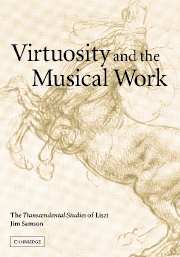2 - Of maps and materials
Published online by Cambridge University Press: 22 September 2009
Summary
ETUDES AND EXERCISES
On the face of it, etude composition should be for teachers, not their pupils, and Liszt's Etude en douze exercices, announcing the end of his years as a prodigy, a ‘second Mozart’, no doubt tells us something about the self-confidence of a fifteen-year-old. Certainly his earlier works were more obviously tailored to the kind of concert tours he had just completed, in Germany, London and the French provinces, and more generally to the world of public pianism. They were also, if anything, even closer compositionally to his piano teacher Czerny, whose many excursions into popular concert genres – variations, fantasies, pot-pourris and the like – are mercifully hidden from view today. In fact it is ironic that, of all things, it was a collection of exercises that helped lift the young Liszt clear of any stylistic dependence on Czerny. It is hardly necessary to flesh out the generic history here, beyond observing that the proliferation of instructional pieces entitled etudes, exercises or leçons was closely tied to the rise of modern conservatories in the late eighteenth and early nineteenth centuries. Indeed there is a real sense in which the etude, at least in its present-day sense, was a creation of the Paris Conservatoire in particular. Professors such as Aubert, Baillot, Cartier, Boisière, Lefevre and Hugot had already issued numerous collections for non-keyboard instruments (especially violin) before Cramer went on to secure the genre title for the piano with his Etude pour le pianoforte, contenant 42 Exercices of 1804, later to be subsumed by the 84 Etudes that comprised Part 5 of his Grosse Pianoforte Schule.
- Type
- Chapter
- Information
- Virtuosity and the Musical WorkThe Transcendental Studies of Liszt, pp. 29 - 65Publisher: Cambridge University PressPrint publication year: 2003

